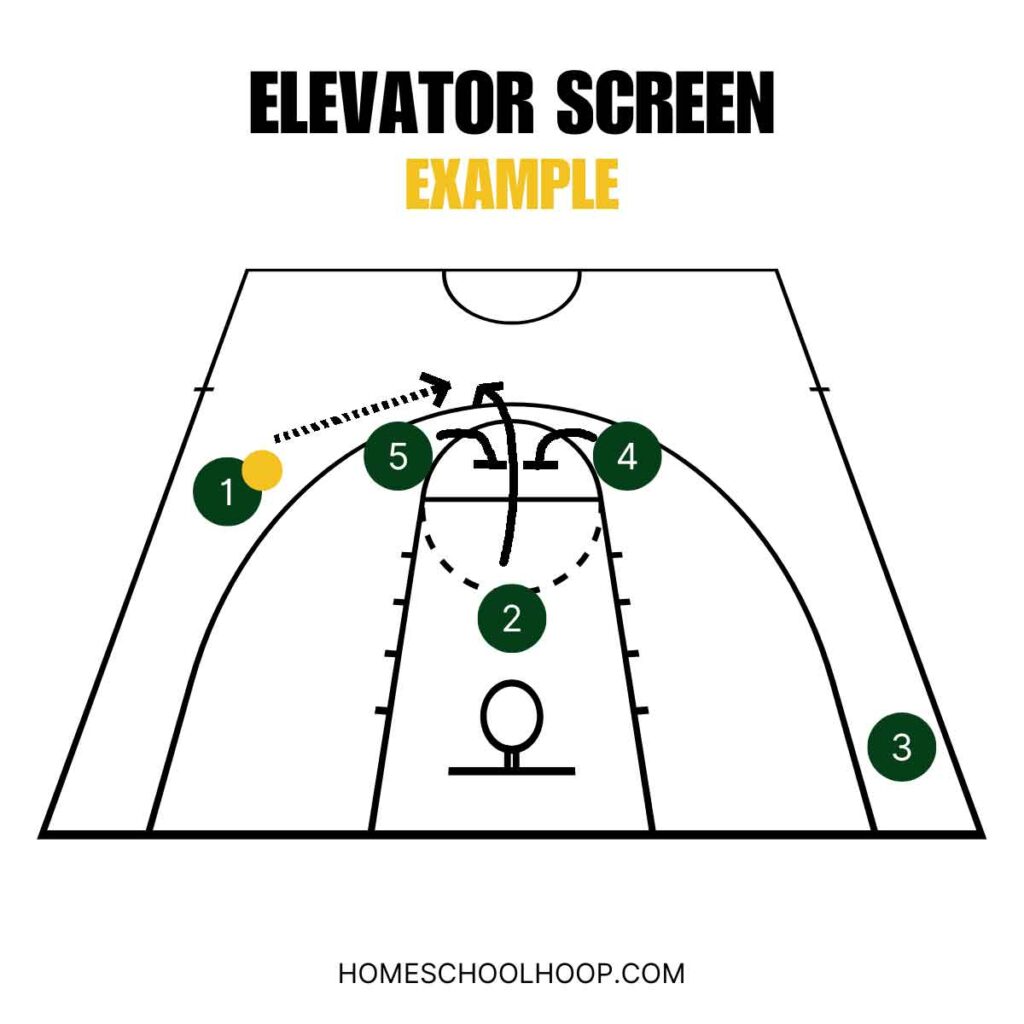When you’ve got a great shooter, setting up strategic plays to get them open looks is crucial. One such tactic to achieve this is the elevator screen. This maneuver involves two teammates acting like elevator doors, coming together to form a screen. As they close, another player dashes through this “door,” breaking free from defenders for a clear shot.
Key Takeaways:
- The elevator screen is an offensive tactic that creates space for shooters to take open shots.
- Two players work together to form the “elevator doors,” closing as a teammate cuts through to open space.
- The play is hard for the defense to navigate when executed correctly, leading to high-quality scoring opportunities.
Here we break down the elevator screen, explaining how it works, its role in offensive strategies, and identifying the players best suited for this play.
Understanding the Elevator Screen
Like any screen in basketball, the elevator screen is an offensive play to get players open for shooting opportunities. What differentiates the elevator screen from most others is that it involves two screeners.
Definition and Basic Mechanics
An elevator screen involves two players, acting like the doors of an elevator, setting a screen for a teammate. The teammate cuts between them, just as the “doors” close, to find an open space for a shot.

The play’s success hinges on timing and coordination, as the screeners must come together at the right moment to block the defender effectively, allowing their teammate to break free.
Here’s the basics of how it works:
- Positioning: Two teammates position themselves near each other, side-by-side.
- Preparation: A third player, the shooter, prepares to run through the gap between them.
- Execution: As the shooter approaches, the screeners move close together, creating a narrow path.
- Breakthrough: The shooter darts through the opening, ideally emerging with a clear shot at the basket.
- Closure: The screeners come fully together, blocking off the path from the defender.
Legal vs. Illegal Elevator Screens
For the offense, executing the elevator screen can be tricky. Because it’s a more complex movement that takes perfect timing and coordination, it can be easier to set an illegal screen.
A screen becomes illegal when a screener leans into a defender, isn’t set when contact is made, or doesn’t give the defender enough space or time to avoid contact. For an elevator screen to be legal:
- Screeners must be stationary when setting the screen, with feet set within shoulder width.
- There should be a reasonable distance between the screeners and the defender to allow them to avoid the screen.
- Timing is critical; screeners must avoid moving or leaning into the defender as contact is made, or they risk getting called for a moving screen foul.
Advantages of Using Elevator Screens
The elevator screen is a common offensive tactic, particularly with teams that have a great shooter. This is because it:
- Creates Open Shots: The dual-screener setup effectively blocks defenders so the shooter can catch a pass and get an open look at the basket.
- Is harder to defend: Two screeners are harder for a defender to navigate than one. The screen is wider with two screeners standing side-by-side.
- Creates confusion: The play can force defenders to switch, creating momentary confusion and potentially causing mismatches.
Executing the Elevator Screen
The elevator screen is a nuanced basketball play that relies heavily on precise execution.
Setting Up the Screen
For the elevator screen to be effective, both the screeners and the player have to set it up right. There are three key points to this:
- Screeners’ Positioning: The two screeners start by standing side-by-side, near the key area but leaving enough space between them for their teammate to cut through – a setup like elevator doors. Their feet should be shoulder-width apart, and they must be ready to move together to “close the doors.”
- Shooter’s Movement: The player intended to use the screen and receive the ball, typically a strong shooter, should start from a position that allows them to run straight through the gap created by the screeners.
- Closing the Gap: As the shooter approaches, the screeners move toward each other to close the gap. This movement should be synchronized and quick, to minimize the defender’s chance to follow the shooter through the screen.
Common Plays Involving Elevator Screens
Elevator screens can be adapted to various offensive sets. A few examples include:
High Post Setup
This is often initiated from a high post position, where the screeners set up near the elbows of the free-throw line. It allows the shooter to cut up from the baseline through the screen for a perimeter shot.
The Golden State Warriors use a variety of screens, from flare screens to back screens, to get open looks for sharpshooters Stephen Curry and Klay Thompson. In the past, they used elevator screens at the high post to get them quick catch-and-shoot opportunities.
Learn more: Stephen Curry Motivational Quotes
Out-of-Bounds Plays
Teams can incorporate elevator action during sideline or baseline out-of-bounds plays, using the confusion of the setup to free a shooter.
In the below example, the Miami Heat use an elevator screen in a side out-of-bounds play to get Tyler Herro an open three-pointer.
Defensive Strategies Against Elevator Screens
Defending against the elevator screen is challenging, particularly if you don’t know it’s coming. Here are some defensive strategies to counter an elevator screen:
- Switching: Defenders can switch assignments on the screen, with the screener’s defender stepping out to cover the shooter as they cut through. This requires immediate communication between the defenders to work.
- Preventing the Cut: A defender can try to anticipate the cut and position themselves between the elevator doors to prevent the shooter from using the screen effectively.
- Fighting Through: The defender of the shooter can also fight through the elevator door gap before it closes by staying right on the shooter’s tail.
- Team Communication: Effective defense against an elevator screen involves all five players communicating, recognizing the setup early, and adjusting their positioning accordingly to cover potential open shooters.
Elevator Screens in Action
There’s no better way to understand the impact a well-executed elevator screen can have than by watching it in action. Let’s take a look at three examples.
Game-Winning Three Pointer
The Seattle Storm demonstrated the power of the elevator screen in a game tied with only 0.8 seconds remaining. Through a sideline out-of-bounds play, Jewell Loyd was freed up by an elevator screen at the top of the key. This strategic move allowed her to drill a three-pointer to clinch the game.
Distract the Defense
The Minnesota Lynx showcased another aspect of the elevator screen’s versatility in a baseline out-of-bounds play. They set up a 4-low formation, intending to use an elevator screen to open a shot for Kayla McBride on the wing. However, the defense’s focus on the anticipated elevator screen left Aerial Powers with a prime opportunity. She exploited her one-on-one matchup, driving to the basket to score an And 1.
Punish a Switching Defense
The Stanford Cardinals illustrated a different use of the elevator action from a sideline out-of-bounds situation. They employed a box-4 setup, with the elevator screen positioned at the high post. As the intended shooter navigated through the screen, the defenders opted to switch, focusing on guarding the shooter. This opened a path for one of the screeners, who cut to the rim.
FAQs
What is an elevator screen?
An elevator screen in basketball is a strategy where two players form a moving barrier, similar to elevator doors closing, for a teammate to cut through to an open space for a shot.
Are elevator screens legal?
Yes, elevator screens are legal in basketball as long as the screeners stay stationary and set their screens within a legal stance, without moving into the defender.
How do you run an elevator screen in basketball?
To run an elevator screen, position two players (screeners) side-by-side near the area where the play is intended to finish, leaving enough room between them for a teammate to pass through. As the shooter cuts through the gap, the screeners move closer together, “closing the elevator doors,” to block the defender.
YOUR OPINIONS ON STRATEGY
Today, you learned about the basketball elevator screen.
So we want to know: What do you think about the use of elevator screens? Do you believe they’re an underutilized offensive tactic or that they’re too complex to be consistently effective?
Let us know in the comments.

